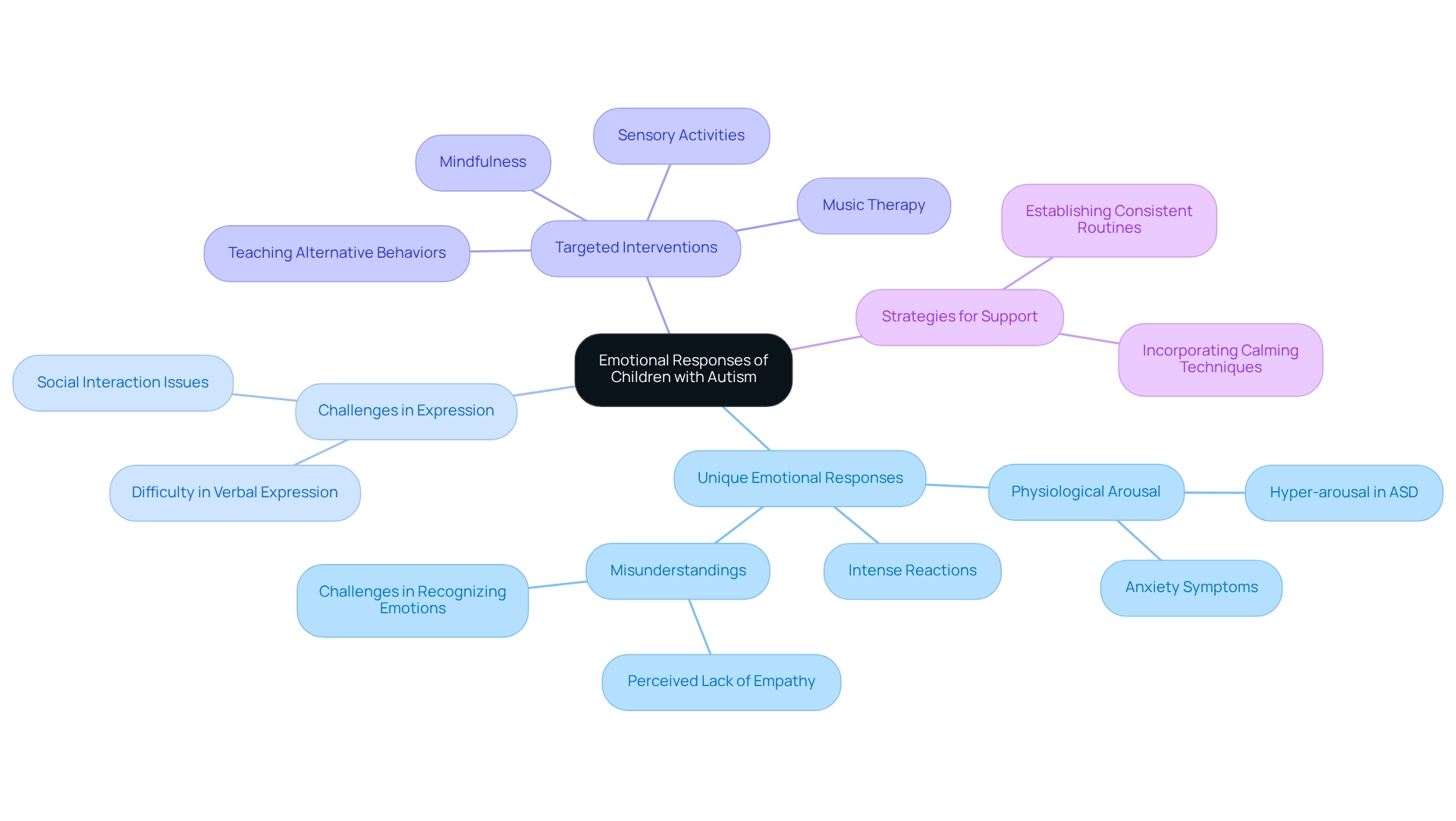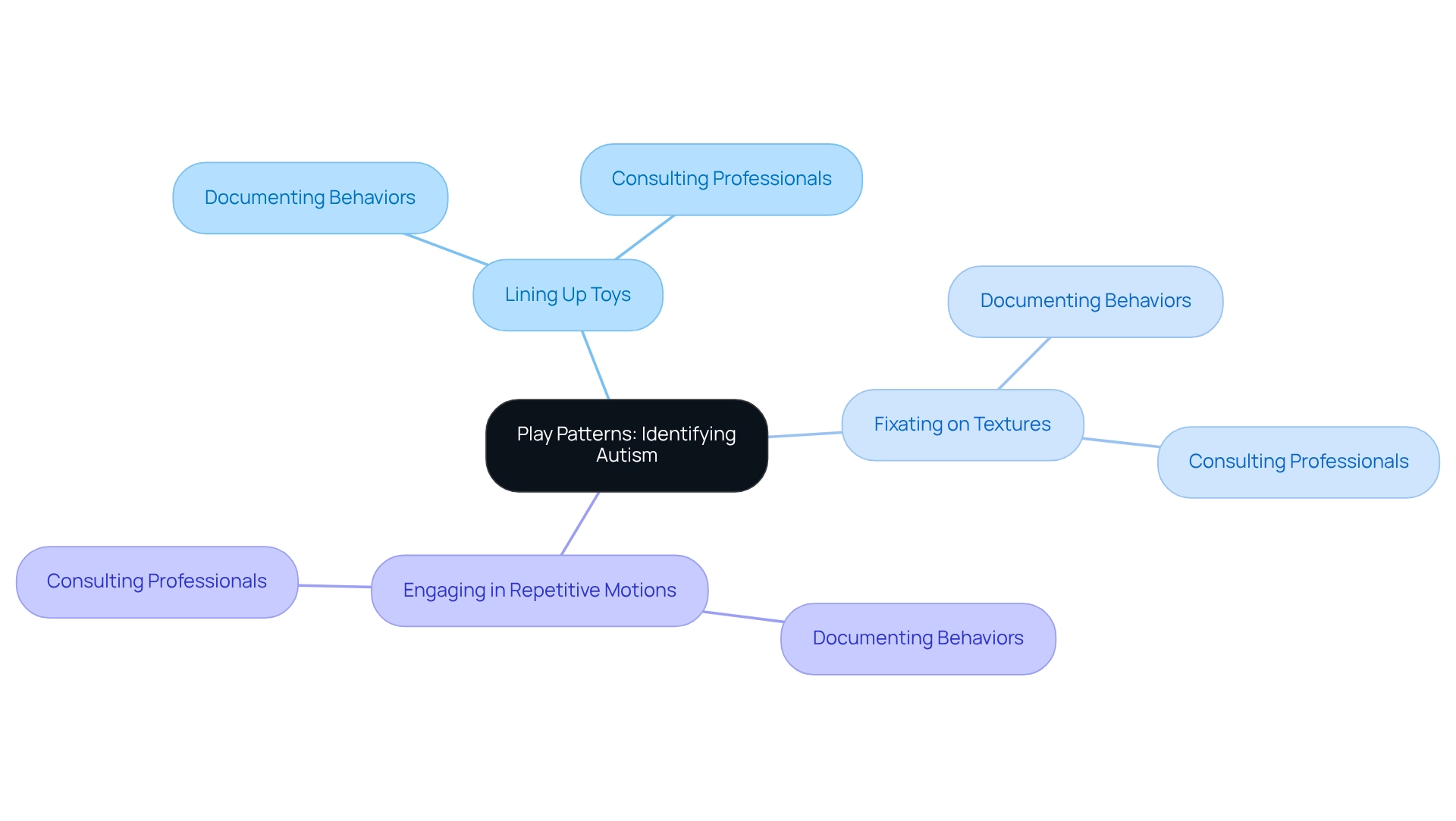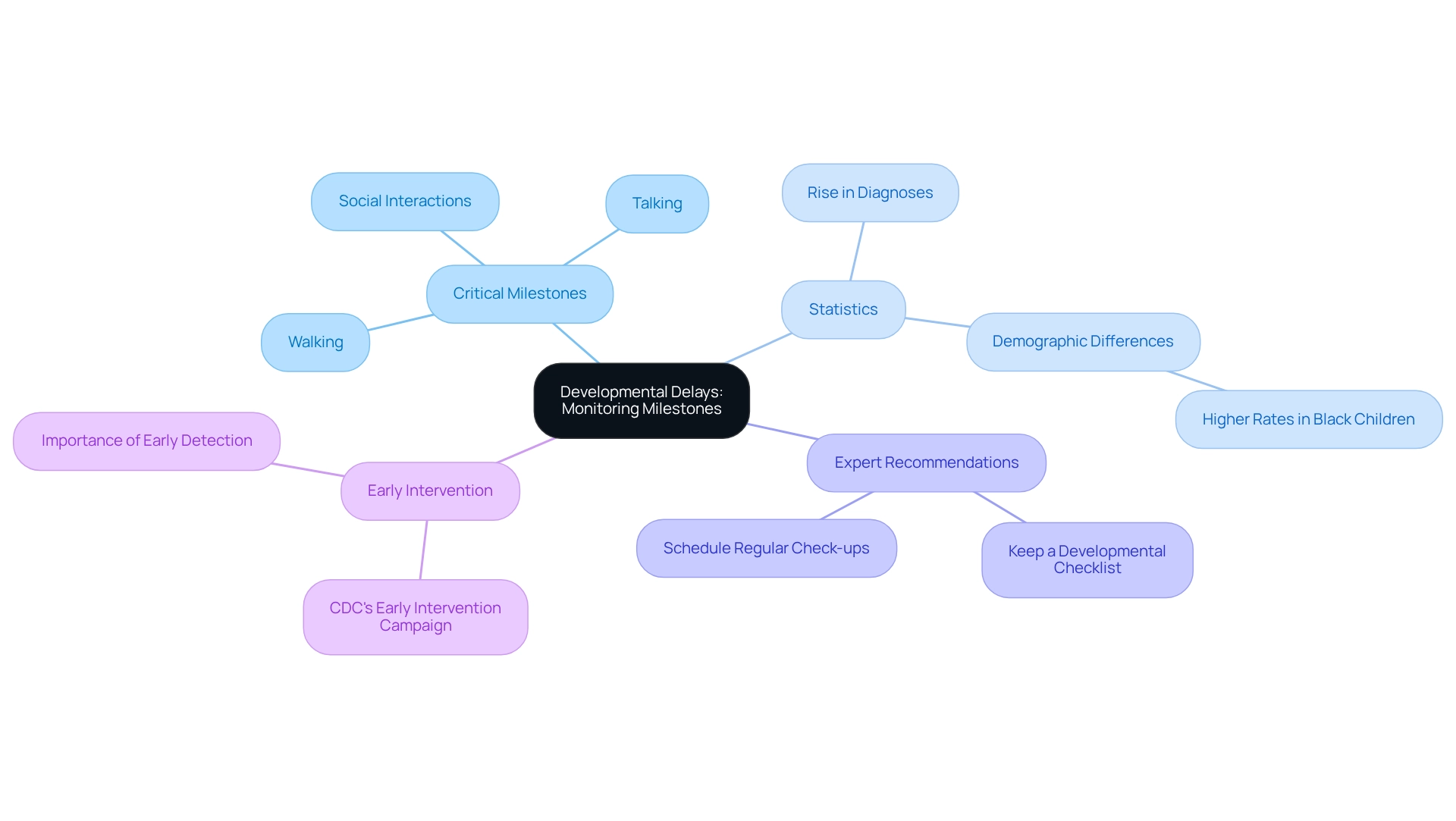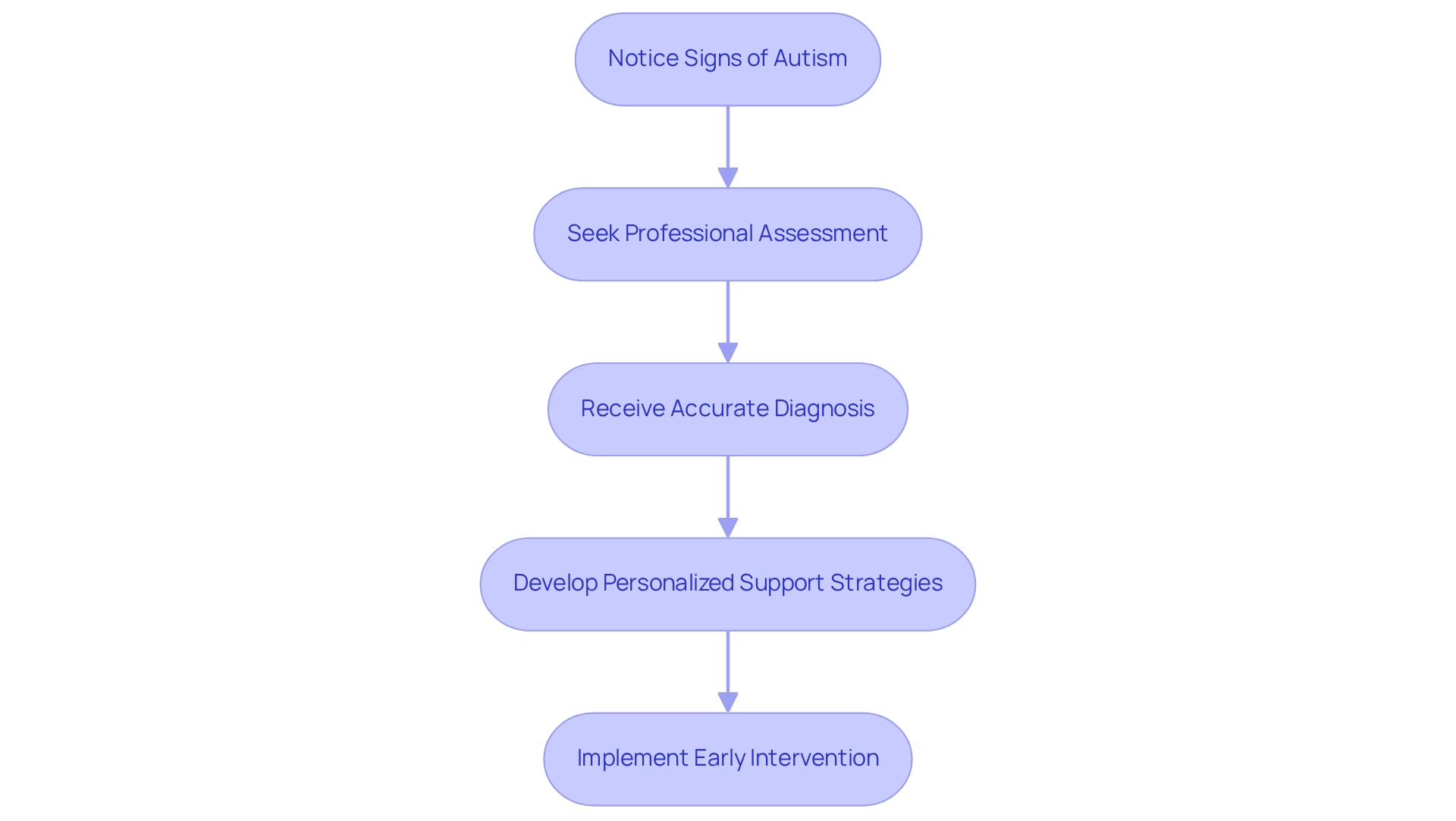Overview
The article "10 Signs of Autism Every Parent Should Recognize" serves as a vital resource for parents striving to understand their children better. It sheds light on essential indicators of autism, such as communication delays, challenges in social interactions, and sensory sensitivities. Recognizing these signs early is not just important; it can lead to timely intervention and support, significantly enhancing developmental outcomes.
As parents, it’s crucial to be aware of these behaviors. Imagine a child struggling to express their feelings or feeling overwhelmed in social settings—these are not just quirks but potential signs of autism. By understanding these indicators, you can take proactive steps to seek help and support.
Early recognition can make a world of difference. It opens the door to resources and interventions that can help your child thrive. If you notice any of these signs, consider reaching out to professionals who can provide guidance and support tailored to your child's needs.
Your journey as a parent can be challenging, but you are not alone. Sharing your experiences and seeking advice from others can be incredibly beneficial. Engage with your community, whether through comments or newsletters, and let’s support each other in this journey of understanding autism together.
Introduction
In a world where awareness and understanding of autism spectrum disorder are increasingly vital, parents hold a pivotal role in recognizing early signs and advocating for their children. From communication delays to unusual emotional responses, the indicators of autism can manifest in various ways, often requiring keen observation and timely intervention. With the right resources, families can navigate the complexities of autism, ensuring their children receive the support they need for growth and development.
This article explores essential signs of autism, empowering parents with the knowledge to identify potential challenges and seek professional guidance. Together, we can foster a more inclusive environment for all children.
About ASD Media: Empowering Parents with Resources for Autism Awareness
At ASD Media, we are deeply committed to enhancing the implementation of ABA therapy, offering valuable insights and strategies that truly address the challenges faced by families and professionals alike. Our focus is on building a supportive and inclusive community, where individuals are encouraged to share their experiences and learn from one another. By subscribing to our newsletter, families can access the latest news and a wealth of digital resources tailored to their unique needs.
We empower parents and professionals to unlock the potential of individuals with neurodevelopmental disorders and ADHD. Our effective strategies help manage challenging behaviors, navigate assistance services, and enhance social skills development. Each personalized treatment strategy is thoughtfully designed to meet specific needs and objectives, ensuring that every young person receives the support essential for their growth.
In 2023, it was reported that 65.8% of age-matched, non-disabled peers were employed, underscoring the importance of early intervention and community assistance in improving outcomes for children with developmental disorders. The mission of ASD Media is further illuminated by the experiences of caregivers like Danyale Sturdivant, who highlighted the profound impact developmental disorders have on families, stressing the urgent need for systemic change and support. Laura, the CEO of Community Support Services, reinforces this sentiment, stating, "it's time to mobilize," which echoes the call for collective action.
Through insightful case studies, such as "Managing Anxiety: Tools and Strategies for Emotional Balance," we showcase multifaceted strategies that promote emotional balance and resilience in autistic individuals. By fostering cooperation and development within the ABA therapy community, ASD Media is dedicated to equipping caregivers with the resources they need to navigate their journey effectively. We recognize the significant challenges faced by Black caregivers dealing with this condition, emphasizing the systemic barriers that must be addressed to ensure comprehensive support for all families.
Communication Delays: Recognizing Early Signs of Autism in Speech Development
Communication delays often serve as early signs of autism, and it is essential for parents to be vigilant about specific developmental milestones. If a young child is not babbling by 12 months or fails to use single words by 16 months, these can be significant signs of autism. By 24 months, children typically should be able to combine words into simple phrases; delays in achieving these milestones warrant further evaluation. Studies indicate that around 20% of children with developmental disorders do not babble by their first birthday, highlighting the critical importance of early identification.
Engaging with speech therapists at an early stage can greatly enhance a child's communication skills. Effective speech therapy interventions have been shown to yield positive outcomes, fostering improved language development and social interaction. For instance, a case study titled "The Power of Words" illustrates how thoughtful language use can inspire change and promote acceptance within communities, ultimately leading to increased awareness and empathy towards individuals with autism. This case study emphasizes that the right approach to language can profoundly influence a child's communication abilities and overall development.
Experts highlight the wisdom of O. Ivar Lovaas, who stated, 'If they can't learn the way we teach, we teach the way they learn.' This method underscores the importance of customizing communication strategies to meet the unique needs of each child. Furthermore, as Jillian Mercado poignantly noted, "Autism is not the enemy; ignorance is," reminding us of the vital role understanding and acceptance play in fostering an inclusive society. By recognizing these early signs of autism and seeking appropriate support, parents can make a significant difference in their child's development. If you notice communication delays in your child, consider consulting with a speech therapist to explore evaluation options and interventions that can truly make a difference.
Social Interaction Challenges: Identifying Signs of Autism in Social Behavior
As a parent, it can be concerning to notice your child struggling with social engagement, which could be signs of autism. Children may exhibit signs of autism by:
- Often evading eye contact
- Failing to respond when their name is called
- Showing little interest in playing with friends
These behaviors can be challenging to understand. They might also struggle to grasp social cues, which can make forming friendships difficult.
It’s important to observe your child’s social interactions closely. If you notice these signs of autism, know that you are not alone, and it’s perfectly okay to seek guidance. Connecting with professionals can provide you with the support and resources you need to navigate these challenges. Remember, reaching out for help is a sign of strength, and it can lead to positive outcomes for your child's social development.
Repetitive Behaviors: Noticing Patterns Indicative of Autism
Repetitive actions, such as hand-flapping, rocking, or arranging toys, can be considered signs of autism among children with developmental disorders. These behaviors often serve as coping mechanisms for managing anxiety or sensory overload.
As a parent, it’s important to observe any recurring behaviors your child exhibits. Have you noticed any patterns? Discussing these observations with a healthcare professional can provide valuable insights, as such behaviors may suggest signs of autism.
Remember, you are not alone in this journey, and seeking support is a vital step in understanding your child's needs.
Sensory Sensitivities: Understanding How They Relate to Autism Signs
Sensory sensitivities are a common trait among many young individuals with developmental disorders, often manifested as heightened reactions to various stimuli such as sounds, lights, or textures. For example, a child might instinctively cover their ears when confronted with loud noises or feel discomfort with certain clothing fabrics. Research indicates that approximately 70% of young individuals with developmental disorders experience increased sensory sensitivities, significantly impacting their daily lives and interactions. This statistic underscores the importance of understanding these sensitivities within the context of neurodevelopmental disorders.
As H.K., a devoted guardian of a child with autism, poignantly shares, "While I love my son and I’m stronger for being an autism mom, I’m still not happy about it." This heartfelt sentiment highlights the emotional complexities that caregivers face, reinforcing the necessity for support and understanding.
Identifying specific triggers is crucial for caregivers aiming to cultivate a supportive environment. By adopting strategies tailored to their child's needs—such as providing noise-canceling headphones in loud settings or choosing soft, tagless clothing to reduce discomfort—parents can significantly enhance their child's quality of life.
Case studies reveal the importance of sensory integration therapy, which has shown promise in assisting young individuals with sensory processing challenges. Through personalized interventions, these children can learn to navigate their sensory experiences more effectively, resulting in improved emotional regulation and social interactions.
Ultimately, fostering an understanding of sensory sensitivities not only aids in recognizing signs of autism but also empowers caregivers to advocate for their child's needs, enhancing their overall quality of life. Grasping how these sensitivities relate to other indicators of the condition can further equip parents in their advocacy efforts.
Unusual Emotional Responses: Recognizing Emotional Indicators of Autism
Children with autism often exhibit unique emotional responses, which can lead to intense reactions to seemingly minor changes in routine or difficulties in calming down after becoming upset. These young individuals may also struggle to express their emotions verbally, resulting in misunderstandings during social interactions. For instance, some children may experience heightened physiological arousal, particularly those showing anxiety symptoms, which can amplify their emotional reactions. Research indicates that a segment of the ASD population may be physiologically hyper-aroused, underscoring the necessity for targeted interventions.
As parents, it’s essential to closely monitor your child's emotional responses and seek help from mental health professionals if you notice significant challenges. Effective interventions, such as teaching appropriate alternative behaviors and skills, are crucial in helping children manage their emotions. Strategies like mindfulness, sensory soothing activities, and music therapy have shown to be beneficial in supporting emotional regulation. As Dr. Conor Davidson emphasizes, enhancing mental health support for autistic individuals can profoundly improve their emotional well-being.
Understanding the emotional landscape of children with signs of autism is vital for fostering better communication and social interactions. Case studies reveal that many young individuals find it challenging to identify and comprehend the feelings of others, which can lead to a perceived lack of empathy. For example, the case study titled "Responding to Other People's Emotions" illustrates how these difficulties impact social interactions, highlighting the importance of targeted support. By addressing these challenges through interventions, including recognizing the signs of autism related to strong reactions to routine changes, caregivers can help their children develop healthier emotional responses and improve their social skills. To implement these strategies at home, consider establishing a consistent routine and incorporating calming techniques during transitions to assist your child in managing emotional fluctuations.

Play Patterns: Identifying Autism Through Unique Play Behaviors
Children often display unique play patterns that can act as early indicators or signs of autism. These behaviors may involve a focused interest in specific parts of toys, rather than engaging with them in typical ways. For example, a young child might repeatedly spin the wheels of a toy car instead of incorporating it into imaginative play scenarios. Such distinctive play behaviors can take various forms, including:
- Lining up toys
- Fixating on certain textures
- Engaging in repetitive motions
As parents, it’s important to be attentive to your child's play habits, as notable deviations from conventional play patterns may indicate signs of autism, suggesting a need for further consultation with professionals. Recognizing these signs of autism early can lead to timely interventions and support, ultimately enhancing your child's developmental outcomes. ASD Media emphasizes the importance of fostering cooperation and growth within the ABA therapy sector, encouraging parents to connect with experts who specialize in supporting individuals with autism. For instance, Adina ABA boasts a team of highly skilled, certified, and insured professionals who prioritize compassion and cultural awareness in their approaches.
To take practical steps, caregivers can start by documenting their child's play behaviors and noting any patterns that seem unusual. Connecting with local support organizations for developmental disorders or consulting with professionals can provide tailored advice to meet their needs. Engaging with community resources can also help caregivers feel supported and informed as they navigate their child's developmental journey.

Developmental Delays: Monitoring Milestones for Early Autism Detection
Developmental delays can be significant indicators of developmental disorders, making it essential for guardians to closely observe their children's progress in achieving vital milestones. These milestones, such as walking, talking, and engaging in social interactions, are critical markers of development. Research shows that individuals exhibiting signs of autism may experience delays in these areas, which can profoundly impact their growth and development. For example, the CDC's Early Intervention Campaign encourages guardians to monitor developmental milestones and seek assessments if they suspect delays. This proactive approach is crucial, as early detection can greatly enhance a young person's long-term outcomes.
Experts stress the importance of keeping an eye on these milestones. Pediatricians often advise parents to remain vigilant, noting that not meeting expected milestones may necessitate further evaluation. Indeed, statistics reveal that developmental delays are common among young children, with a notable increase in diagnoses related to signs of autism in recent years. In 2021, the rates of developmental disorders were particularly high among Black children, underscoring the urgent need for equitable access to early intervention resources, ensuring that all children receive the support they need.
Maureen Durkin, Chair of the University of Wisconsin-Madison's Department of Population Health Sciences, emphasizes the significance of this issue, stating, "It makes sense that there is higher prevalence, and points to things we could do to prevent it. But for a while, I believe we were under-identifying the condition." By understanding and recognizing these developmental delays, caregivers can take informed steps toward seeking support and intervention. Engaging with healthcare professionals from the outset can lead to effective strategies that foster better outcomes for children with developmental disorders.
To empower parents, it is vital to actively monitor milestones and seek evaluations when necessary. Keeping a developmental checklist and scheduling regular check-ups with pediatricians can help ensure that any concerns are addressed promptly.

Limited Interests: Recognizing Fixations as Early Signs of Autism
Children with developmental disorders often exhibit restricted interests, frequently fixating on particular subjects or items. For instance, a young person may develop an intense fascination with trains, collecting various toy models and engaging in detailed discussions about them. While having strong interests is common, an intense concentration on a limited set of topics can suggest a developmental disorder. Studies indicate that roughly 70% of youngsters with developmental disorders display limited interests, which may manifest as repetitive actions or a strong dedication to specific topics.
Experts emphasize that these fixations can serve as both a hallmark and signs of autism, as well as a potential avenue for therapeutic engagement. Utilizing a young person's limited interests in therapy can boost motivation and enhance social interactions, leading to more effective interventions. A case study titled 'Leveraging Restricted Interests in Therapy' illustrates how incorporating a young person's specific interests can create engaging and effective interventions that promote social engagement and development.
Parents who are concerned about these behaviors should consult with a healthcare provider to discuss their observations and explore early assessment options. Consulting with a pediatrician for an early evaluation of developmental disorders is essential for timely intervention. Identifying these signs of autism early can significantly influence a young person's developmental path, enabling prompt intervention methods that promote skill enhancement and alleviate symptoms linked to the condition. As Haley Moss insightfully notes, "I might hit developmental and societal milestones in a different order than my peers, but I am able to accomplish these small victories on my own time." This viewpoint emphasizes the importance of recognizing that each individual's journey is unique, and early detection can lead to better developmental outcomes.
Professional Evaluation: The Key to Understanding Autism Signs and Support Needs
If you notice signs of autism in your child, it is crucial to seek a professional assessment. Understanding the signs of autism can be overwhelming, but a comprehensive evaluation by a qualified healthcare provider can lead to an accurate diagnosis and personalized support strategies. Early intervention plays a vital role in improving outcomes for children with autism. Therefore, it’s essential for parents to act quickly if they have concerns. Remember, you are not alone in this journey—reaching out for help is a strong and positive step forward.

Conclusion
Recognizing the signs of autism spectrum disorder is an essential journey for parents, allowing them to advocate effectively for their children. In this article, we have explored key indicators such as:
- Communication delays
- Social interaction challenges
- Unusual emotional responses
These insights underscore the importance of early detection and intervention. By understanding these early signs, parents are empowered to seek professional guidance and support, creating an environment that nurtures their child's growth.
Additionally, our discussion on:
- Sensory sensitivities
- Repetitive behaviors
- Limited interests
highlights the diverse ways autism can manifest. By staying vigilant and proactive, parents can identify these patterns and collaborate with healthcare providers to develop tailored strategies that meet their child's unique needs. The emphasis on professional evaluations further reinforces the necessity of timely assessments, ensuring that children receive the support they need to thrive.
Ultimately, equipping parents with knowledge about autism is crucial for fostering a more inclusive society. By providing families with the right tools and resources, we can enhance developmental outcomes for children with autism. Together, through awareness and advocacy, we can forge a brighter future for all children, regardless of their challenges. What steps will you take today to support your child and others in your community?
Frequently Asked Questions
What is the mission of ASD Media?
ASD Media is committed to enhancing the implementation of ABA therapy by providing valuable insights and strategies to address the challenges faced by families and professionals. They aim to build a supportive community where individuals can share experiences and learn from one another.
How does ASD Media support families and professionals?
ASD Media empowers parents and professionals by offering effective strategies to manage challenging behaviors, navigate assistance services, and enhance social skills development. They provide personalized treatment strategies tailored to meet specific needs and objectives.
What statistics highlight the importance of early intervention for children with developmental disorders?
In 2023, it was reported that 65.8% of age-matched, non-disabled peers were employed, emphasizing the significance of early intervention and community assistance in improving outcomes for children with developmental disorders.
What are some signs of autism that parents should look for in their children?
Parents should be vigilant for signs such as not babbling by 12 months, failing to use single words by 16 months, and not combining words into simple phrases by 24 months. Delays in these milestones may warrant further evaluation.
How can speech therapy benefit children with communication delays?
Engaging with speech therapists early can significantly enhance a child's communication skills, leading to positive outcomes in language development and social interaction. Effective interventions can foster improved communication abilities.
What should parents do if they notice signs of autism in their child?
Parents should closely observe their child's social interactions and seek guidance from professionals if they notice signs of autism. Reaching out for help is a sign of strength and can lead to positive outcomes for the child's development.
What is the significance of customizing communication strategies for children with autism?
Customizing communication strategies is essential because, as O. Ivar Lovaas stated, "If they can’t learn the way we teach, we teach the way they learn." This approach addresses the unique needs of each child, promoting better learning and communication.




